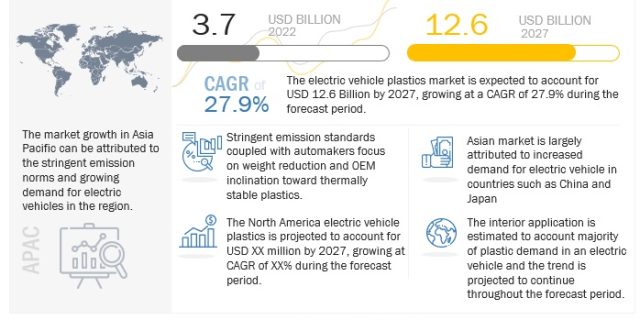
The electric vehicle plastics market is projected to grow from USD 3.7 billion in 2022 to USD 12.6 billion by 2027, at a CAGR of 27.9% during the forecast period.
Race to reduce the vehicle’s overall weight to increase driving range and emissions, along with increasing demand for superior quality vehicle interiors, are some of the driving factors of the electric vehicle plastics market.
Polypropylene is the new favourite material amongst OEMs for low weight plastic components
Polypropylene is a thermoplastic formed from a combination of propylene monomers. Polypropylene is also often used as a binder for thermoplastic component for composites made from natural fiber. Polypropylene is a bad conductor of electricity that makes it a suitable material to make electronic components for interior applications. It is also one of the lightest plastic materials commercially available with density of 0.905 g/cm3 which makes it ideal for making lightweight components from. PP is also extremely weather resistant and has good chemical resistant properties that makes it an attractive option for exterior vehicle applications such as bumpers. These mechiancal properties allows for significant overall vehicle weight reduction when components from polypropylene materials are used. Reducing the weight of a vehicle improves it fuel efficiency and increases driving range thus reducing over all vehicular CO2 emissions. Reducing CO2 emissions is a top priority for many nations which makes propylene a very attractive material to be used in electric vehicles which have seen a tremendous rise in adoption globally. This is expected to have the fastest growth rate amongst other plastic materials.
Request Sample Report: https://www.marketsandmarkets.com/requestsampleNew.asp?id=219387183
Lighting and Electric wiring application to witness the fastest growth rate by application
Electric cars are in need of more wires, cables and connectors as compared to Internal Combustion Engines. EVs have on-board chargers to convert AC electric current to DC for battery storage. While charging these chargers develop high heat due to high voltage transfer thus, plastics that can with stand elevated temperatures can find larger application here. With components such as alternators, inverters, sensors and battery connections the need for safe and efficient wiring becomes imperative. Also, customer preference has shifted they preference and now demand more features in their vehicle that may include a better infotainment system or sensor applications or ambient lighting. This opens up opportunities for more plastic applications in interior segment. Better lighting for navigating traffic helps passengers stay safe in driving in areas with low visibility hence it’s important for headlights and fog lamps to have good transparency so that the passenger can have best visibility. This again opens up opportunities for the application of plastics, such as Polycarbonate, which has good strength and high transparency, for lighting application. Autonomous electric vehicles are another segment where there has been observed an increased demand for wiring applications due to large number of sensors and electrical components needed for them to function.
Thus technological advancements and demand for better interior features is likely to drive the plastics demand in electric vehicle lighting and wiring application.
North American region to be the second fastest market by value
According to IEA, in the US the share of EV sold increased from 2.2% in 2020 to 4.6 % in 2021 and increase of 109.1 %. Additionally, government regulations such as the recently introduced amendments in the “Clean Air Act”, to increase the adoption of electric vehicles over ICE vehicles and increasing customer preference for electric vehicles in the region. OEMs in the US are shifting their focus towards reducing the overall weight of the vehicle irrespective of their propulsion type. Reducing weight in EVs will increase their driving range and in ICEs will improve fuel efficiency hence reduce CO2 emissions. Using plastics components allows to do so. Government regulations and increasing customer awareness regarding the environment has prompted OEMs to adoption higher ratio of plastic components in their products in the country. Plastics components like Polycarbonate provide good mechanical properties hence find application in vehicle interiors and safety components. Canada, similar to US, is largely focused on reducing vehicular emissions and increasing safety. Plastic Components are light in weight and have good crash absorbing characteristics which allows them to find higher adoption in vehicles. BEVs and PHEVs due to their battery components and electrical wiring require more plastic components hence higher sales of these vehicles will drive plastic component demand in Canada.
Inquire Before Buying: https://www.marketsandmarkets.com/Enquiry_Before_BuyingNew.asp?id=219387183
Thus, large focus on improving driving range of vehicles and reducing vehicular CO2 emissions will drive OEMs to adopt light weight high performance plastic components in their products in the region. This is likey to drive the demand for plastics in EVs in North America.
Related Reports:
Automotive Seats Market – Global Forecast to 2030
Asia Pacific Electric 3-Wheeler Market – Global Forecast to 2028
Electric Trucks Market – Global Forecast to 2030

